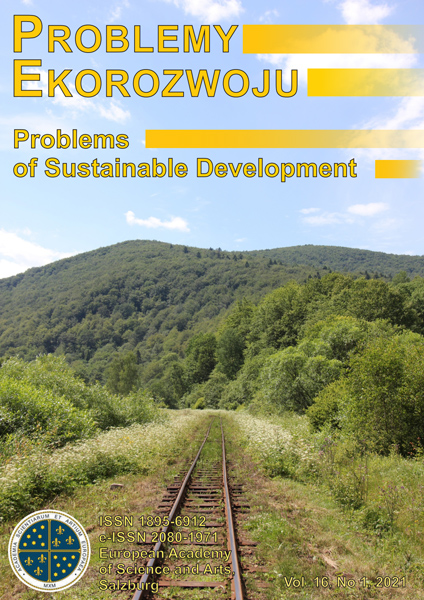ALEXANDRA L., 2010, Corruption and the environmental Kuznets Curve: Empirical evidence for sulfur, in: Ecological Economics, 69, p. 2191-2201.
DOI: https://doi.org/10.1016/j.ecolecon.2010.06.004
ANUT K. B., MOHAMMAD R. F., MARCEL T., 2012, Pollution, shadow economy and corruption: Theory and evidence, in: Ecological Economics, 75, p. 114-125.
DOI: https://doi.org/10.1016/j.ecolecon.2012.01.007
ANITYASARI M., RACHMAT A. N., 2015, Lesson Learnt from Top-down Selection of Medium Enterprises for Green Industry Pilot Project in Surabaya, in: Industrial Engineering and Service Science, 04, p. 54-61.
DOI: https://doi.org/10.1016/j.promfg.2015.11.014
BISWAS A. K., THUM M., 2017, Corruption, environmental regulation and market entry, in: Environment & Development Economics, 22, p. 66-83.
DOI: https://doi.org/10.1017/S1355770X16000218
BOUTILIER R. G., 2017, Original article: Raiding the honey pot: The resource curse and weak institutions at the project level, in: The Extractive Industries and Society, 04, p. 310-320.
DOI: https://doi.org/10.1016/j.exis.2017.02.002
BEKHET H. A., OTHMAN N. S., 2018, The role of renewable energy to validate dynamic interaction between CO2 emissions and GDP toward sustainable development in Malaysia, in: Energy Economics, 72, p. 47-61.
DOI: https://doi.org/10.1016/j.eneco.2018.03.028
CHERNI J. A., 2002, Economic Growth Versus the Environment : The Politics of Wealth, Health and Air Pollution, Palgrave Macmillan: Houndmills, Basingstoke, Hampshire.
CHAABOUNI S., SAIDI K., 2017, The dynamic links between carbon dioxide (CO2) emissions, health spending and GDP growth: A case study for 51 countries, in: Environmental Research, 158, p. 137-144.
CHAABOUNI S., SAIDI K., 2017, The dynamic links between carbon dioxide (CO2) emissions, health spending and GDP growth: A case study for 51 countries, in: Environmental Research, 158, p. 137-144.
DOI: https://doi.org/10.1016/j.envres.2017.05.041
DREWS S., ANTAL M., VAN D. B., JEROEN C.J.M., 2018, Analysis: Challenges in Assessing Public Opinion on Economic Growth Versus Environment: Considering European and US Data, in: Ecological Economics, 146, p. 265-272.
DOI: https://doi.org/10.1016/j.ecolecon.2017.11.006
ELLIOTT L., 2007, Transnational Environmental Crime in the Asia-Pacific: an “under secutized” security problem?, in: The Pacific Review, 20, p. 499-522.
DOI: https://doi.org/10.1080/09512740701671995
ELLIOTT L., 2011, Transnational Environmental Crime: Applying network theory to an investigation of illegal trade, criminal activity and law enforcement responses, Transnational Environmental Crime Project, Working paper, no 1.
ENGLE R. F., GRANGER C. W. G., 1987, Econometric forecasting: a brief survey of current and future techniques, in: Climate Change, 11, p. 117-139.
DOI: https://doi.org/10.1007/978-94-009-4011-6_6
FREDRIKSSON P. G., HERMAN R.J. V., ELBERT D., 2004, Corruption and energy efficiency in OECD countries: theory and evidence, in: Journal of Environmental Economics and Management, 47, p. 207-231.
DOI: https://doi.org/10.1016/j.jeem.2003.08.001
FAIZ R., MUHAMMAD N., FAIZA K., 2012, Nexus between corruption and regional Environmental Kuznets Curve: the case of South Asian countries., in: Environment, Development and Sustainability, 14, p. 827.
DOI: https://doi.org/10.1007/s10668-012-9356-6
FRIEDL B., GETZNER M., 2003, Determinants of CO2 emissions in a small open economy, in: Ecol. Econ, 01, p. 133-148.
DOI: https://doi.org/10.1016/S0921-8009(03)00008-9
HUANG Y., LIU L., 2014, Fighting corruption: A long-standing challenge for environmental regulation in China, in: Environmental Development, 06, p. 1-3.
DOI: https://doi.org/10.1016/j.envdev.2014.06.001
INFANTE D., SMIRNOVA J., 2016, Environmental Technology Choice in the Presence of Corruption and the Rule of Law Enforcement, in: Transformations in Business and Economics, 15, p. 214-224.
KAO C., CHIANG M. H., 2000, On the estimation and inference of a cointegrated regression in panel data, in: Adv Econometrics, 15, p. 179-222.
DOI: https://doi.org/10.1016/S0731-9053(00)15007-8
LORENZO P., 2008, Corruption, Development and the Environment, Vrige University.
NIU J., CHANG C. P., YANG X. Y.,WANG J. S., 2017, The long relationships between energy efficiency and environmental performance: Global evidence, in: Energy and Environment, 06, p. 1-19.
OLE M. L., MARINA P., 2018, Do Political Institutions Moderate the GDP-CO2 Relationship? in: Ecological Economics, 145, p. 441-450.
DOI: https://doi.org/10.1016/j.ecolecon.2017.11.014
PEDRONI P., 2004, Panel cointegration: asymptotic and finite sample properties of fooled time series tests with an application to the PPP hypothesis, in: Econometric Theory, 20, p. 597-625.
DOI: https://doi.org/10.1017/S0266466604203073
PHILLIPS P. C. B., HANSEN B. E., 1990, Statistical inference in instrumental variables regression with the I (1) process, in: Rev Econ Dtud, 57, p. 99-125.
DOI: https://doi.org/10.2307/2297545
WEI B. L., BIN C., JIN Y. 2011, Temporal and Spatial Analysis of Integrated Energy and Environment Efficiency in China Based on a Green GDP Index, in: Energies, 9, p.1376-1390.
DOI: https://doi.org/10.3390/en4091376
ZHANG Y. J., JIN Y. L., CHEVALLIER J., SHEN B., 2016, The effect of corruption on carbon dioxide emissions in APEC countries: A panel quantile regression analysis, in: Technological Forecasting & Social Change, 112, p. 220-227.
DOI: https://doi.org/10.1016/j.techfore.2016.05.027







